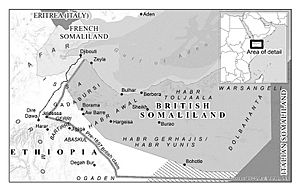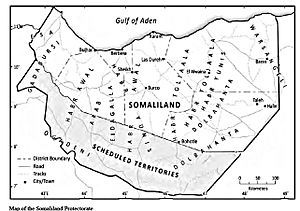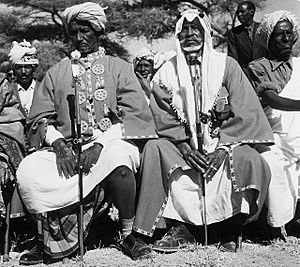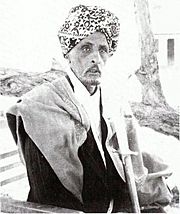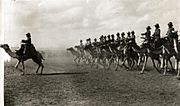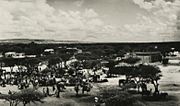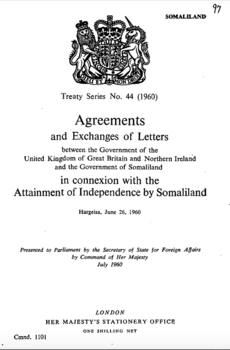British Somaliland facts for kids
Quick facts for kids
Somaliland Protectorate
|
|||||||||||||||||
|---|---|---|---|---|---|---|---|---|---|---|---|---|---|---|---|---|---|
| 1884–1940 1941–1960 |
|||||||||||||||||
|
|
|||||||||||||||||
|
Anthem: God Save the Queen (1862–1901 & 1952–1960) God save the King (1901–1940 & 1941–1952)
|
|||||||||||||||||
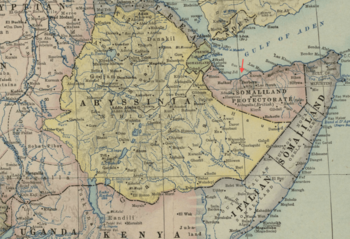
British Somaliland in 1922
|
|||||||||||||||||
| Status | Self-ruling sultanates under British Protection (administered by the Government of India until 1 October 1898) |
||||||||||||||||
| Capital | Berbera (until 1941) Hargeisa (from 1941) |
||||||||||||||||
| Common languages | Somali, Arabic, English | ||||||||||||||||
| Religion | Islam | ||||||||||||||||
| Governor | |||||||||||||||||
|
• 1884–1888 (first)
|
Frederick Mercer Hunter | ||||||||||||||||
|
• 1959–1960 (last)
|
Douglas Hall | ||||||||||||||||
| History | |||||||||||||||||
|
• British control
|
1884 | ||||||||||||||||
|
• Protection treaties
|
1886 | ||||||||||||||||
|
• Somali coast protectorate
|
20 July 1887 | ||||||||||||||||
| 1900–1920 | |||||||||||||||||
| 3 August 1940 | |||||||||||||||||
| 8 April 1941 | |||||||||||||||||
|
• Independence
|
26 June 1960 | ||||||||||||||||
|
• Somali unification
|
1 July 1960 | ||||||||||||||||
| Area | |||||||||||||||||
| 1904 | 137,270 km2 (53,000 sq mi) | ||||||||||||||||
| Population | |||||||||||||||||
|
• 1904
|
153,018 | ||||||||||||||||
| Currency | Rupee (1884–1941) East African shilling (1941–1962) |
||||||||||||||||
|
|||||||||||||||||
| Today part of | Somaliland | ||||||||||||||||
British Somaliland, officially called the Somaliland Protectorate, was a land in modern Somaliland that was once controlled by the British Empire. A "protectorate" means it was a territory protected and partly controlled by a stronger country.
During its time, British Somaliland shared borders with Italian Somalia, French Somali Coast, and Abyssinia (which was temporarily Italian Ethiopia). From 1940 to 1941, Italian forces took over the area. It became part of their Italian East Africa territory.
On June 26, 1960, British Somaliland became independent. It was then known as the State of Somaliland. Just five days later, on July 1, 1960, it joined with the Trust Territory of Somalia (which used to be Italian Somalia). Together, they formed the Somali Republic. Today, Somaliland is a self-declared independent state. However, most countries still see it as an autonomous region within Somalia.
Contents
History of British Somaliland
How British Somaliland Started
In the late 1800s, the United Kingdom made agreements with several local clans. These clans included the Gadabuursi, Issa, Habr Awal, Garhajis, Habr Je'lo, and Warsengeli. These agreements created the protectorate.
The British managed the protectorate from their colony in British India until 1898. After that, different British government offices took over its administration.
The British were not very interested in the region's resources. Their main goals were to get meat supplies for their base in Aden. They also wanted to stop the slave trade and keep other foreign powers away. The area was even nicknamed "Aden's butcher's shop." The British mostly controlled the coastal areas. They did not build much government structure further inland. This was different from how the Italians managed their nearby colony.
The Dervish Uprising
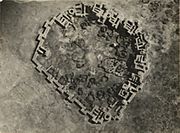
Starting in 1899, the British faced a long resistance movement. This movement was led by Sayyid Mohammed Abdullah Hassan. The British called him the "Mad Mullah." His followers were known as the Dervishes.
The British sent many military groups to try and stop Hassan. But they were not successful for a long time. In 1913, Hassan's forces defeated the British Somaliland Camel Constabulary. Hassan had avoided capture many times before this.
In 1914, the British created the Somaliland Camel Corps. This group was meant to help keep order in the protectorate.
Finally, in 1920, the British launched their last major attack. They used new military aircraft for the first time in this region. They bombed the city of Taleh, where many Dervish troops were. This forced Hassan to retreat. He died in 1921. This ended his twenty-year fight against the British.
The Somaliland Camel Corps
The Somaliland Camel Corps was a special unit of the British Army. It was based in British Somaliland from the early 1900s until 1944. The soldiers in this corps had a unique uniform.
Their uniform was based on the standard British Army khaki drill. But it also included a knitted woollen pullover. They had drill patches on their shoulders. They wore shorts with woollen socks and "chaplis," which are colorful sandals. Sometimes they wore boots or went barefoot. Their equipment included a leather ammunition belt and a waist belt. Officers wore pith helmets and khaki drill uniforms. Other soldiers wore a "kullah" (a type of cap) with a "puggree." A puggree is a strip of cloth wrapped around a hat. It often hung down the back to shade the neck.
British Somaliland in the 1920s and 1930s
After the Dervish resistance ended, the British had two main goals. They wanted to keep the protectorate stable. They also wanted it to be able to support itself financially. The second goal was hard to reach. Local people often resisted paying taxes. These taxes would have helped pay for the protectorate's administration.
By the 1930s, the British presence had grown. It extended to more parts of British Somaliland. More trade encouraged some livestock herders to move to towns. Taxes on goods also helped pay for British India's patrols along Somalia's Red Sea coast.
Italian Invasion during World War II
In August 1940, during World War II, Italy invaded British Somaliland. The few British forces tried to defend the main road to Berbera. But they were forced to retreat after losing the Battle of Tug Argan.
During this time, the British gathered soldiers and government workers. They evacuated about 7,000 people, including civilians, from the territory. Somali soldiers in the Somaliland Camel Corps could choose to leave or stay. Most chose to stay and were allowed to keep their weapons.
In March 1941, British forces recaptured the protectorate. This was after six months of Italian control. The last Italian resistance in British Somaliland ended by late 1943.
Independence and Union

In May 1960, the British Government announced it would grant independence to the Somaliland protectorate. The local council in British Somaliland had already asked for independence in April 1960. Both legislative councils in the territory agreed to this plan.
In April 1960, leaders from both territories met in Mogadishu. They agreed to form one united state. They decided there would be an elected president as head of state. A prime minister would have executive powers. This prime minister would answer to an elected National Assembly with 123 members.
On June 26, 1960, British Somaliland became independent. It was named the State of Somaliland. Five days later, on July 1, 1960, it joined with the Trust Territory of Somalia. Together, they formed the Somali Republic (Somalia).
The legislature chose Hagi Bashir Ismail Yousuf as the first President of the Somali National Assembly. On the same day, Aden Abdullah Osman Daar became President of the Somali Republic.
How British Somaliland was Governed
- Further information: List of colonial governors of British Somaliland
Until 1898, British Somaliland was managed by the British official in Aden. It was like a part of the Government of India. From 1898, the British Foreign Office took over. Then, from 1905 onwards, the Colonial Office managed it. There was a short period of military rule after the Italian invasion.
Until 1957, the Governor held all the power. He had a council to give him advice, but it wasn't legally required. In 1947, an advisory council was set up. It included representatives from different communities. In 1957, a Legislative Council and an Executive Council were created. Elections for the Legislative Council began in 1959. A new constitution was introduced in 1960, just before independence.
Modern Somaliland
In 1991, after a civil war, the area that was once British Somaliland declared its independence. This new state was called the "Republic of Somaliland." Its local government sees itself as the successor to the old British Somaliland. However, no other country in the world officially recognizes Somaliland as an independent nation.
Postage Stamps
Images for kids





